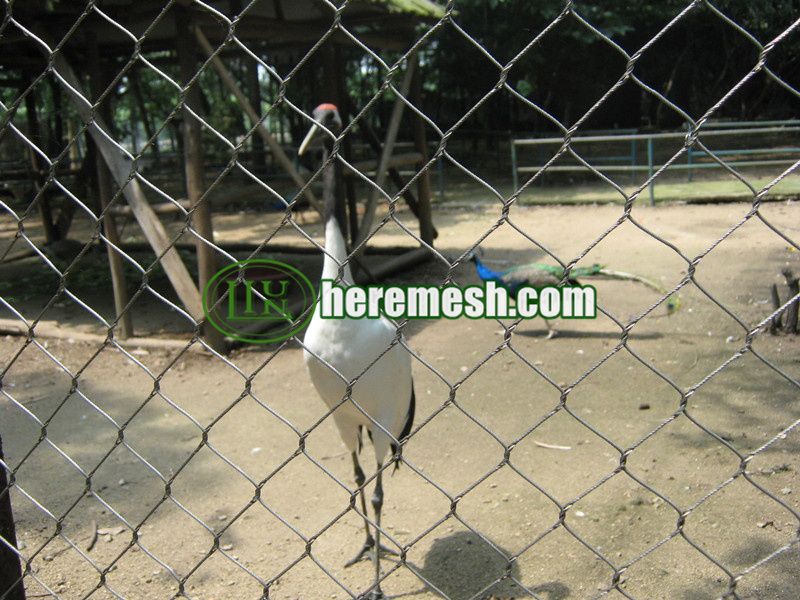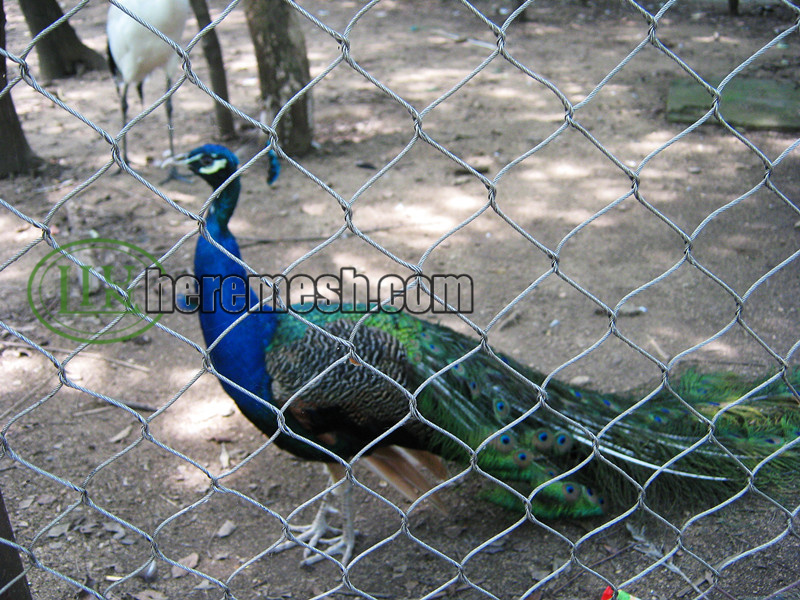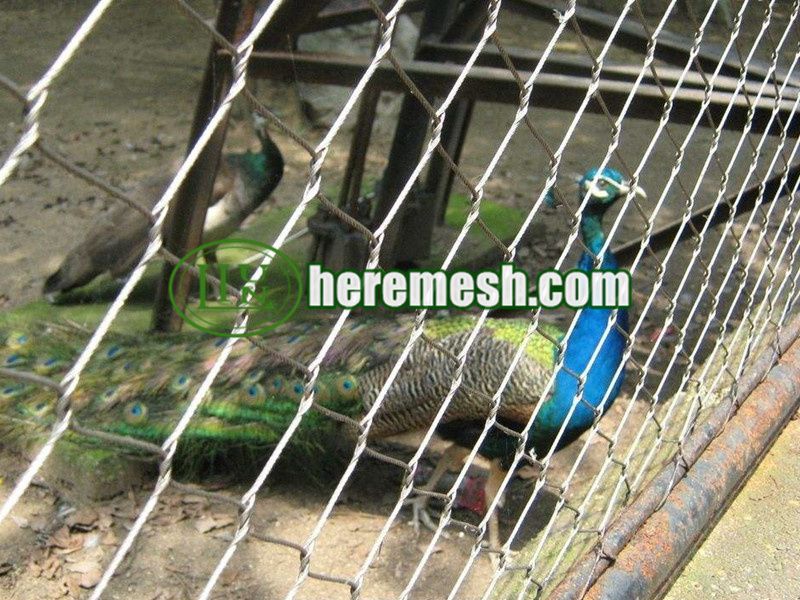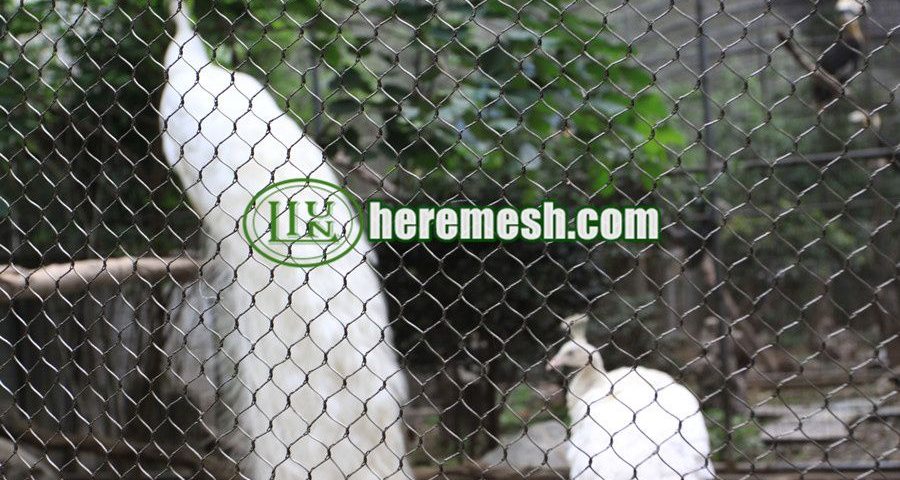The Applications of Hand Woven Mesh in Large Bird Aviaries

Ferrule Type Mesh Order Delivery for Wolf Enclosure Mesh
04/22/2025What is large bird aviaries?
Large bird aviaries are type of living space designed specifically for large birds. It has significantly different characteristics and functions compared to a normal aviary. Large bird aviaries are often referred to as those that provide a feeding environment for larger birds with high activity requirements. These birds include ostriches, peacocks, cranes, hornbills, flamingos, and so on. These types of aviaries not only need to provide basic shelter functions, but also need to meet the complex behavioral needs. Such as flight, activity, and socialization.
In terms of size, large bird aviaries tend to be much larger than regular aviary. A standard large bird aviary may needs to be 10 meters long, 5 meters wide, and 3 meters high. Raptor aviaries may require a much larger flight area. This difference in size leads directly to differences in building materials, structural design and construction methods. Ordinary small aviaries may be adequate using timber and wire mesh. Large bird aviary, on the other hand, requires stronger, more durable materials to ensure safety and stability for long-term use.
Functionally, large bird aviaries typically need to replicate a variety of environmental elements of a bird’s natural habitat. In addition to basic shelter, there are flight areas, perching logs, water areas, feeding areas, and breeding areas to consider.
In terms of purpose of use, large bird aviaries are commonly found in places such as zoos, bird parks and bird sanctuaries. They are not only used for display, but more importantly, to provide birds with a living environment suitable for the characteristics of their species. This purpose is crucial to both the physical and psychological health of the birds.
Differences between the large bird aviaries and other bird aviaries
There are many essential differences between large bird aviaries and ordinary small bird aviaries. These differences are mainly in terms of spatial scale, structural strength and longevity. Understanding these differences is essential to the proper design and construction of large bird houses.
The difference is most obvious in the size of the space.
The average small aviary may have only a few cubic meters of space and is suitable for small birds. Medium-sized aviaries are about 10-20 cubic meters and can house medium-sized parrots or pigeons. Large birds aviaries, on the other hand, often require hundreds or even thousands of cubic meters of space. In the case of raptors, for example, the recommended minimum size of an aviary for a golden eagle is 12 meters (L) x 6 meters (W) x 6 meters (H). So it can meet its basic flight needs. This huge difference in space has a direct impact on the choice of building materials and structural design.
The structural strength requirements are very different.
Small birds have limited impact on the structure of the aviary. And ordinary metal mesh and wooden frames are sufficient. Large birds have extremely strong impacts and chewing abilities. So ordinary materials will soon be destroyed. Large bird aviaries must be reinforced structure. Aviary netting materials need to have higher tensile strength and impact resistance. Stainless steel rope mesh is the ideal choice because of its excellent mechanical properties. It can withstand all kinds of physical impacts from large birds without deformation or breakage.
There is also a significant difference in service life and maintenance needs.
While ordinary aviaries may require replacement or overhaul after 3-5 years of use. Stainless steel wire rope mesh is typically designed to last 20 years or more. Stainless steel, with its excellent corrosion resistance, can withstand bird droppings, rain, cleaning agents for a long time. This advantage greatly reduces maintenance frequency and costs. This is especially important for cost-sensitive zoos and sanctuaries.
Safety considerations are more stringent.
Large birds are often potentially dangerous. The sharp talons of raptors and the beaks of large parrots can cause serious injury. Large bird aviaries must be designed to ensure that birds cannot escape while protecting keepers and visitors. The high strength and difficult-to-break nature of stainless steel rope mesh provides reliable security. The mesh size also needs to be precisely calculated, both to prevent birds from getting their heads or limbs stuck and to ensure that they are unable to break or pass through the aviary.
Perform outstandingly in aesthetics.
From an aesthetic point of view, large birds aviaries often need to harmonize with the surrounding landscape or even become part of the display. Stainless steel rope mesh has a strong sense of modernity and good reflective properties. It can create a bright and transparent visual effect. It can reduce the sense of oppression to the birds, providing visitors with good observation conditions. This is a clear difference from ordinary aviary that only focus on functionality and ignore aesthetics.


The benefit of building large bird aviary
Building a professional large bird aviary offers significant multiple benefits in terms of animal welfare, conservation education and long-term investment. Large bird aviaries constructed with stainless steel wire rope mesh add durability and economy to these benefits.
From an animal welfare point of view, large bird aviaries provide large birds with near-natural living space, which is essential for their physical and mental health. Adequate flight space allows for healthy physical development of the birds. It can effectively reduce the need to avoid stereotypical behaviors. The smooth surface of the stainless steel material facilitates thorough cleaning and sanitizing, preventing the growth of pathogens. Studies have shown that birds living in suitably large aviaries have significantly higher reproductive success, longevity and behavioral enrichment. The secure boundaries created by stainless steel rope mesh allow birds to move freely without fear of escape or injury.
For conservation education, the large bird aviary provides an excellent opportunity for the public to observe and understand large birds. The well-designed stainless steel rope mesh structure hardly obstructs the line of sight. And visitors can clearly observe the natural behaviors of the birds. This intuitive educational experience is more convincing than pictures or videos and can effectively raise public awareness of bird conservation. Many zoos and sanctuaries use the large bird aviary to conduct educational programs on the ecology of birds, the threats they face and conservation measures.
In the long run, investing in a high quality stainless steel aviary can pay off in the long run. Although the initial cost is high, its long service life and very low maintenance requirements reduce the overall operating costs.
Factors to consider when building large bird aviary
The successful construction of a safe and durable large bird aviary requires comprehensive consideration of numerous interrelated factors. When building a large bird aviary, choosing stainless steel rope mesh requires a comprehensive consideration of multiple factors such as material, strength, durability and budget. These considerations should start from the needs of birds and take into account practicality, economy and sustainability.
Stainless steel rope mesh is an ideal choice due to its excellent corrosion resistance and high strength. There are two materials, 304 stainless steel and 316 stainless steel. They are not prone to rust in a humid environment and can maintain structural integrity for a long time. In terms of strength, the diameter and weaving method of the rope mesh directly affect its load-bearing capacity and impact resistance. Administrators need to select appropriate specifications based on the size and activity habits of birds. So it can both prevent birds from escaping and resist external damage. Durability is closely related to the material and surface treatment process.
High-quality stainless steel rope nets are not prone to aging or becoming brittle even when exposed to wind and sun for a long time, reducing maintenance frequency and replacement costs. Although the initial investment in stainless steel rope mesh is relatively high, its long service life and low maintenance characteristics often reduce the overall cost during long-term use. Therefore, when the budget permits, it is more economical and reasonable to give priority to choosing 316 stainless steel with better corrosion resistance or 304 stainless steel that has undergone special oxidation treatment. In addition, it is necessary to combine the specific design and environmental conditions of the aviary, balance performance and cost. Ensure that the selected materials can not only meet the functional requirements but also avoid unnecessary waste of resources.


What kind of stainless steel rope mesh should be chosen as large bird aviaries material?
Choosing the appropriate stainless steel rope mesh material is a key decision to ensure the quality and safety of aviaries. Professional material selection requires a comprehensive consideration of multiple factors such as material quality, product specifications, corrosion resistance and cost.
The grade of stainless steel material is the primary consideration.
304 stainless steel is the most commonly used choice, featuring excellent corrosion resistance and suitability for most inland environments. 316 stainless steel is more corrosion-resistant than 304 material. And it is the first choice for coastal areas or near chemical plants. For particularly harsh environments or permanent facilities, 316 stainless steel can be considered. It has higher strength and excellent corrosion resistance.
Different species choose mesh of different specifications.
The rope diameter and mesh aperture need to be precisely matched according to the characteristics of the birds. The rope diameter is usually selected within the range of 1.6mm to 2.4mm. For large raptors or powerful parrots, it is recommended to use a rope diameter of 1.6mm or more. The mesh aperture must ensure that birds neither get their heads stuck through nor are damaged by their beaks or claws. The general principle is that the diagonal length of the mesh is less than 1.5 times the diameter of the bird’s head. For instance, macaw aviary recommend a 50mm×50mm mesh, while large raptors may require a larger mesh. In special circumstances, smaller aperture can be selected, using denser mesh at the bottom to prevent small prey from escaping.
The process and surface treatment affect the performance of the rope mesh.
Weaving is the most common structure, providing uniform strength and permeability. The cross-woven rope mesh is more flexible and suitable for designs with complex curved surfaces. For coastal and humid areas, stainless steel oxide mesh with better corrosion resistance can be chosen. The black oxidized surface reduces glare and has a beautiful appearance.
Budget cost is the basis for the final decision.
When evaluating costs, one should not only look at the product price but also calculate the full life cycle cost. This includes installation, maintenance, replacement and disposal costs. Although high-quality stainless steel large aviary mesh has a high unit price, their service life of over 30 years and extremely low maintenance requirements often make them the most economical choice. In addition, it is necessary to avoid situations where the escape or injury of birds due to material issues may cause huge losses. Professional suppliers can provide detailed technical support to help users make rational choices.


